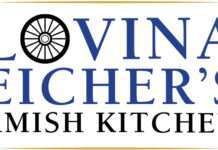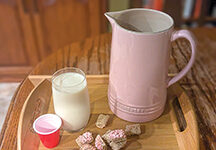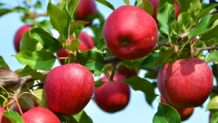Making safe homemade ice cream
Written from materials by Karma Metzgar & Susan Mills-Gray, Nutrition and Health Education Specialists; Reviewed by Londa Nwadike, State Food Safety Specialist, University of Missouri Extension
At one time uncooked eggs were used to make ice cream, but now we know in order to reduce the risk of Salmonella poisoning, a custard-based recipe, an eggless recipe or a recipe using an egg substitute should be used.
“Homemade ice cream is a special treat for many, but every year it causes several outbreaks of Salmonella infection with up to several hundred victims at church picnics, family reunions or other large gatherings,” says John Sheehan, director of the Food and Drug Administration’s Division of Dairy and Egg Safety. The ice cream ingredient most often responsible for the outbreaks: raw (uncooked) or undercooked eggs. The Center for Disease Control and Prevention reports 45-50 outbreaks annually in the United States, resulting in illness in more than 1,300 people.
A person infected with Salmonella Enteritidis (SE), the strain of salmonella found most frequently in raw eggs, usually has fever, diarrhea and abdominal cramps beginning 12 to 72 hours after eating or drinking a contaminated food or beverage. The infection generally lasts four to seven days, and most people recover without any treatment. But for those at high risk — infants, older people, pregnant women and people with a weakened immune system — it can be life threatening.
While commercially manufactured ice cream is typically made with pasteurized eggs or egg products, recipes for homemade ice cream often use raw eggs in the base mixture. Homemade ice cream can be made with eggs without the risk of Salmonella infection by preparing it safely.
Here are some safe alternatives to using raw eggs in your homemade ice cream:
- Use pasteurized shell eggs or pasteurized egg substitutes instead of raw eggs, if the recipe calls for that. Pasteurized shell eggs can be found in the dairy section while egg substitutes can be found in either the dairy case near the regular eggs or in the frozen food section. The FDA requires that pasteurized shell eggs be individually marked or specially packaged to prevent intermingling with unpasteurized eggs. The pasteurized egg product needs to be the whole egg (not just the whites) or the texture of the ice cream will not be rich and creamy (see more about ice cream texture below).
- Even when using pasteurized eggs, the FDA and the USDA advise consumers to start with a cooked base for optimal safety, especially if serving people at high risk for foodborne illness. Additionally, it’s important to only use pasteurized milk and cream products in making your homemade ice cream.
- Use a recipe that contains a cooked custard base. The custard base must reach 160 degrees F to kill the Salmonella bacteria. Resist the temptation to taste-test it during preparation because the custard isn’t fully cooked and could still contain Salmonella. After cooking, chill the custard thoroughly before freezing.
Ice cream texture
Ice cream’s texture comes from the use of milk fat and sugar. The more fat in the milk, the smoother the frozen ice cream will be. If you use 1% or skim milk for a low-fat option, the resulting ice cream will have a lot of ice crystals in it making it flat and lower in volume. Try 2% milk instead of whole milk. The end result will be smooth and creamy, but lower in fat.
Sugar is another ingredient that helps create ice cream’s texture. By adding sugar, you raise the freezing temperature of your ice cream mixture. This allows you to be able to freeze it with ice, water and salt. So not only do you end up with a sweet treat, but it’s also easier to scoop.
Try one of the recipes below.
Homemade Eggless Ice Cream
- 2 cups milk
- 1 cup sugar
- 2 cups whipping cream or half-and-half
- 2 teaspoons vanilla
Combine and stir until sugar is dissolved, then pour into a one-gallon ice cream freezer can and freeze according to manufacturer’s directions.
Ice Cream in a Bag
- 2% chocolate milk (can also use whole white milk with fruit or syrup)
- Snack-sized zip lock bag
- Quart-sized freezer zip lock bag
- Ice
- Rock salt
- Pour 1/2 cup milk into snack bag. Close tightly.
- Put 2-3 cups of ice into the quart-sized freezer bag.
- Sprinkle a little rock salt on the ice.
- Slip the closed baggie of milk into the bag with the ice. Close tightly.
- Shake vigorously until the milk is frozen, being careful not to break either bag.
- Remove the small bag with the ice cream. You’ll want to wipe the salty water from the outside of the bag and the baggie seal so your ice cream won’t taste salty.
- Unzip the ice cream baggie, insert spoon and eat.
**An added bonus — no dishes!
Frozen Custard Ice Cream (makes 1½ to 2 quarts)
- 6 eggs
- 2 cups milk
- 3/4 cup sugar
- 1/4 teaspoon salt
- 2 cups whipping cream
- 1 tablespoon vanilla
- In medium saucepan, beat together eggs, milk, sugar and salt.
- Cook over low heat, stirring constantly, until mixture is thick enough to coat a metal spoon with a thin film and reaches at least 160 degrees F.
- Cool quickly by setting pan in ice or cold water and stirring for a few minutes.
- Cover and refrigerate until thoroughly chilled, at least one hour.
- When ready to freeze, pour chilled custard, whipping cream and vanilla into one-gallon ice cream freezer can.
- Freeze according to manufacturer’s directions.
VARIATIONS
Banana Nut: Reduce vanilla to 1½ teaspoons. Cook and cool as above. Stir three large ripe, mashed bananas and 1/2 cup chopped toasted pecans into custard mixture. Freeze as above.
Cherry: Reduce vanilla to 1 teaspoon. Add 2 tablespoons almond extract. Cook and cool as above. Partially freeze. Add 2 pounds pitted pureed dark sweet fresh cherries OR 1 can (16-17 ounces) pitted dark sweet cherries, drained and chopped. Complete freezing.
Chocolate: Add three squares (1 ounce each) unsweetened chocolate to egg mixture. Cook, cool and freeze as above.
Plum: Reduce vanilla to 1 teaspoon. Cook and cool as above. Partially freeze. Add 1½ pounds pitted, pureed,
ripe, fresh plums. Complete freezing.
Strawberry: Omit vanilla. Cook and cool as above. Partially freeze. Add 2 cups sweetened, crushed fresh strawberries. Complete freezing.
Photo credit: Sarah Sphar – CC BY-ND 2.0




